Robotics Education Journal
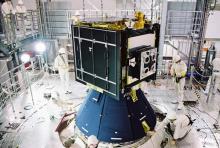 02/22/2019
02/22/2019 Underscoring an eventful week in robotic space exploration, the Japanese Hayabusa-2 spacecraft successfully completed a key part of its sample capture mission on carbonaceous asteroid Ryugu. Managed by JAXA (the Japan Aerospace Exploration Agency), the Hayabusa spacecraft shot a specially engineered 5-gram metallic “bullet” into Ryugu’s surface rock and collected sample particles rebounding from the bullet’s impact. This was just one of several sample gathering activities in this phase of the multifaceted Hayabusa-2 mission. The collected rock particles will be brought back to the Earth in 2020 for analysis. NREF has compiled a series of images from across the web to illustrate the current phase of this remarkable robotic mission.
 02/19/2019
02/19/2019 The Haidilao restaurant chain in China is the largest chain specializing in Szechuan-style hot pot cuisine. Teaming with Panasonic, Haidilao recently upgraded its restaurants with AI-driven robot kitchen assistants, cooks and food servers. Mobile robots teaming with humans serve customized dishes prepared according to customer preferences. The kitchen is driven with artificial intelligence (AI) in Haidilao's new “smart store” approach to doing business.
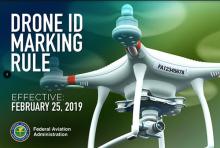 02/16/2019
02/16/2019 The Federal Aviation Administration (FAA) posted a rule in the Federal Register requiring small drone owners to display the FAA-issued registration number on an outside surface of the aircraft. This rule applies to pilots of unmanned aerial systems (UAS) as well as pilots of traditional model RC aircraft flown at radio control club fields sanctioned by the Academy of Model Aeronautics (AMA). Owners and operators may no longer place or write registration numbers in an interior compartment. The rule is effective on February 25. The markings must be in place for any flight after that date. This new requirement will facilitate identification of drone pilots and their aircraft should the need arise.
 02/12/2019
02/12/2019 SAN DIEGO, CA, January 30, 2019 – Planck Aerosystems (Planck Aero) recently received authorization from Marine Corps Air Station (MCAS) Miramar, Air Traffic Control (ATC) to test the Shearwater sUAS in controlled airspace and at night. Planck’s Shearwater sUAS repeatedly preformed successful autonomous takeoffs and precision landings onto a moving, off-road ground vehicle with centimeter-level accuracy in complete darkness without the need for GPS or a pilot in the loop. Nighttime operations from moving vehicles represents a major step forward in the demonstrating the maturity of Planck’s vision-based navigation solution.
 02/11/2019
02/11/2019 The president’s executive order on AI, signed Monday February 11, is intended to preserve America’s technology leadership. It also asks for the development of regulatory standards to, among other things, preserve citizen privacy in the face of this technology, which standards don’t currently exist. Importantly, the order directs that the National Council for the American Worker and AI select committee set up "fellowship and training programs" to help U.S. workers learn the skills needed to work with and develop AI technologies. That is a key component.
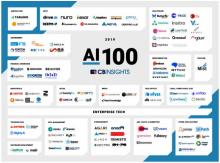 02/09/2019
02/09/2019 CB Insight’s recommended “most promising 100 AI startups working across the artificial intelligence value chain, from hardware and data infrastructure to industrial applications,” is a fascinating compilation. These companies are listed and linked to, here.
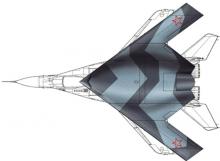 02/05/2019
02/05/2019 David Place’s unmanned systems blog recently reported that an image of an apparent prototype of Russia's Okhotnik (Hunter) heavy unmanned aerial vehicle (UAV) has begun to circulate in Russian social media. Design and development of the Okhotnik Udarno-Razvedivatelnyi Bespilotnyi Kompleks (Unmanned Strike-Reconnaissance System) by Sukhoi is thought to have commenced in 2011. Also designated as the S-70, its take-off weight is reported to be about 20 tonnes, with, some sources say, a top speed of 1,000 km/h.
 02/02/2019
02/02/2019 Progress toward the elusive Holy Grail of machine sentience may finally be on the horizon. If robots are to adapt to unforeseen circumstances, they must learn to simulate themselves, reports Hod Lipson, director of CMU’s Creative Machines Lab. In a study, Lipson and his PhD student Robert Kwiatkowski used a 4 DoF robot arm that used “deep learning” to create a model of itself. “…after less than 35 hours of training, the self-model became consistent with the physical robot to within about four centimeters …the robot was able to grasp objects at specific locations on the ground and deposit them into a receptacle with 100 percent success.”
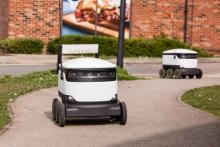 01/25/2019
01/25/2019 Venturebeat.com reported that Starship Technologies, in a collaboration with food-and-facilities-management company Sodexo, has begun using a fleet of mobile robots to deliver food to 40,000 students and faculty at George Mason University’s Fairfax campus, in Fairfax, Virginia. “Students and teachers have little free time as it is, so there is a convenience for them to have their food, groceries and packages delivered to them,” said Ryan Tuohy, Starship Technology’s senior vice president of business development. “Our goal is to make life easier, whether that means skipping the line, eating lunch on the lawn rather than in the cafe, or finding the time to eat better when studying for exams.”
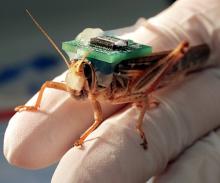 01/13/2019
01/13/2019 The Defense Advanced Research Projects Agency (DARPA) has published a solicitation for simplified artificial intelligence (AI) computers modeled on insect brains, some of which include less than 1,000 neurons. DARPA seeks AI systems that require less power, data and complexity than conventional approaches to AI.
 01/09/2019
01/09/2019 Byron Spice reported from Carnegie Mellon University’s National Robotics Engineering Center (NREC) that NREC is building the largest robot in its 22-year history. “Its 45-foot-tall gantry, visible from Pittsburgh’s 40th Street Bridge, was built as part of a U.S. Army Corps of Engineers prototyping project to automate its annual mat-sinking operations on the Mississippi River. The massive mats, which consist of concrete blocks wired together, shield riverbanks from erosion, helping to protect levees and ensure safe river navigation.
“As big as it is, the prototype robot being built on NREC’s front lawn will serve only to test and further develop systems that will become part of the final, much larger robot – a floating factory called ARMOR 1 – that eventually will be deployed on barges on the Mississippi.”
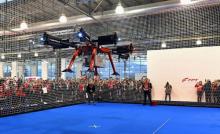 12/25/2018
12/25/2018 The new Guinness World Record for the heaviest payload lifted by a drone is now held by the Forvola Mega Drone. This very impressive machine is the result of a collaborative effort by FPT Industrial and Forvola, and was recently shown during FPT Industrial’s Tech day.
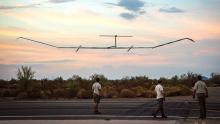 12/17/2018
12/17/2018 Jon Bornstein, president and chief operating officer of Amprius, the Sunnyvale, California-based company that provided high energy-density lithium-ion cells for the Airbus’ record-breaking Zephyr solar-powered stratospheric unmanned aircraft, says Amprius is working with electric vertical-takeoff-and-landing (eVTOL) developers. Their new cells have a specific energy of 435 Wh/kg, compared to the 300-325 Wh/kg of conventional lithium-ion batteries. The secret is in the new silicon nanowire anode.
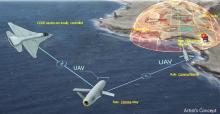 12/07/2018
12/07/2018 As reported by C4ISRnet.com, DARPA has successfully controlled drone swarms in the face of intensive jamming in what is characterized as denied or contested airspace. Interestingly, the goal of DARPA’s Collaborative Operations in Denied Environment (CODE) program the test was “for CODE’s human operator to monitor the swarm without micromanaging it, and instead to allow the autonomous drones to improvise and adjust as they pursue their mission.”
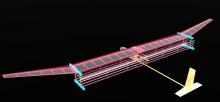 11/28/2018
11/28/2018 A completely silent fixed wing aircraft with a roughly 5-meter wingspan recently flew for 16 seconds across a distance of 60 meters just feet above the wooden floor in a spacious sports gym at the Massachusetts Institute of Technology. Ion wind propulsion technology (aka “electroaerodynamic thrust”) has been discussed since the 1920s—but only now have converging technologies permitted a practical test.
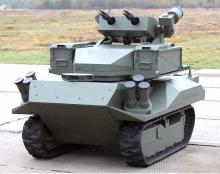 11/16/2018
11/16/2018 As reported by the AUVSI daily ebrief, Belarus’ Belspetsvneshtekhnika (BSVT) has developed an unmanned combat ground vehicle (UCGV) for export. The robot is named the Self-Propelled Robotized System (SPRS) “Berserk” and can operate singly, or in a team. Jane’s notes it can undertake a 24-hour patrol along pre-programmed routes while tracking objects of interest. It is equipped with (2) color cameras and (2) thermal imagers for day/night operations, and has a top speed of 5 km/h. It carries (2) 4-barrelled 7.62mm GShG Miniguns that are said to be able to hit airborne targets moving at up to 300 Km/h at 1 km distance.
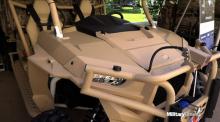 11/06/2018
11/06/2018 The Marines want an unmanned vehicle capable of keeping up with its rifle squad and conducting squad resupply to unburden the grunt. A Request For Information recently posted on the Federal Business Opportunities website keeps options open, telling interested industry partners that the mode could be a “robotic applique” on existing systems, a remote-controlled vehicle or a fully autonomous transport.
 10/23/2018
10/23/2018 Are you ready to discover the future of technology? Harbour.Space University and Remy Robotics are collaborating to offer 20 graduate students from anywhere in the world a once in a lifetime opportunity: a fully funded scholarship for Harbour.Space University’s progressive Master’s program in Robotics! Students, everywhere, take note!
 10/21/2018
10/21/2018 DARPA’s research into brain-computer interfaces has moved to new horizons, with a human subject now able to mentally control multiple vehicles, and astoundingly, receive intelligible sensor feedback directly into his brain, apparently sidestepping gazing at a screen or haptic feedback.
“As of today, signals from the brain can be used to command and control … not just one aircraft but three simultaneous types of aircraft,” said Justin Sanchez, who directs DARPA’s biological technology office, at the Agency’s 60th-anniversary event in Maryland. …DARPA was able to improve the interaction between pilot and the simulated jet to allow the operator, a paralyzed man named Nathan, to not just send but receive signals from the craft.
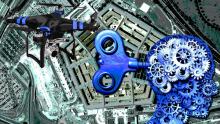 10/15/2018
10/15/2018 The next war might include mind-controlled drones. DARPA has overseen trials using mind-controlled drones for use by the military. According to The Daily Beast, these trials were computer simulations that are the precursor to what could lead to robotics that are controlled by the mind of a human operator.
 10/07/2018
10/07/2018 As the Army integrates robots into its formations, from mule-like transports to single-soldier controlled drone swarms, it’s reaching out to industry and coming up with some novel solutions. This Venus Flytrap-like system has caught its eye.
 10/05/2018
10/05/2018 This new dexterous extension to your smart phone seems to be creepy, cool and weird, all at once. But when you think about it, doesn’t it make sense to equip your smart phone with some form of ambulation?
 10/03/2018
10/03/2018 The closing of Rethink Robotics is sad news, as this company was a pioneer in the development of robots that were emotionally sympathetic. One gravitated to Baxter at a trade show because the robot smiled back and looked at you, and its intelligently controlled end effectors appeared to be easily trainable working next to a human partner--breaking down the barriers between human and robot and helping establish the cobot concept. It seemed a remarkable step forward.
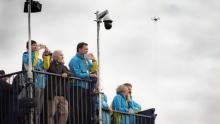 10/02/2018
10/02/2018 The ORION tethered drone aerial surveillance system was successfully deployed for 6 days at the Ryder Cup 2018, held September 25-30 in Paris. Every 2 years, the Ryder Cup gathers 24 of the world's top golfers from the U.S. and Europe for this packed event. It is viewed by an estimated billion+ television spectators in 200 countries! The 42nd edition -- held this year in Paris at Le Golf National, next to Versailles -- is estimated to have reached 300,000 TV viewers in the last 6 days of September. The tethered drone system is a key asset because it enables the authorities to efficiently monitor crowd flow and better ensure event safety. This drone assignment came soon after other recent deployments of the tethered drone system at the French national air show, Ferté Alais, and the 2018 World Motorbike Championship.

